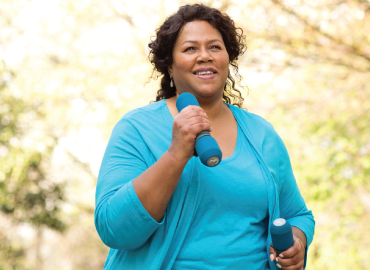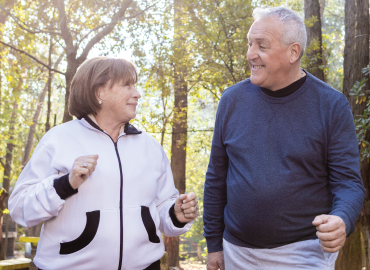Long COVID Movement and Exercise
 You may have been less active since having COVID-19, causing your muscles to become weaker and your body overall less fit. Managing long COVID symptoms such as fatigue (See Managing Fatigue from Long COVID for more information) and breathlessness (See Managing Breathlessness from Long COVID for more information) can make getting moving harder. However, slowly starting to move and exercise again is important for your health. Moving often, eating well, and managing your long COVID symptoms may help you recover, be stronger, live and feel better overall.
You may have been less active since having COVID-19, causing your muscles to become weaker and your body overall less fit. Managing long COVID symptoms such as fatigue (See Managing Fatigue from Long COVID for more information) and breathlessness (See Managing Breathlessness from Long COVID for more information) can make getting moving harder. However, slowly starting to move and exercise again is important for your health. Moving often, eating well, and managing your long COVID symptoms may help you recover, be stronger, live and feel better overall.
Movement and exercise is important to your health because it may help:
- Make you stronger and more fit so you can do more
- Boost your mood, help manage stress and anxiety
- Improve sleep
- Reduce stiff joints
- Reduce pain
- Manage and reduce the risk of other conditions such as COPD, heart disease, and diabetes
- Manage weight
- Increase your energy level
- Strengthen your bones and your body’s ability to fight infections
Tips Before you Get Started
- Ask your health care team before starting a new exercise program
- Ask your health care team if you should use a walking aid
- Try working with a physiotherapist, exercise therapist, enrolling in a pulmonary rehabilitation or a long COVID exercise program to get started
- Try exercising with someone when starting out
10 Tips for Becoming More Active
- Set small short-term goals
- Keep an activity diary to record the times you have exercised and to track your progress
- Build up slowly
- Do small amounts of movement at first and slowly build over time
- Exercise often
- To start, do a little movement, but often. Build movement into your everyday routine
- Plan it out
- Choose a time of the day where you have the most energy to get moving
- Treat your exercise time like an appointment
- Do not exercise on a full stomach. Wait 1-2 hours after eating a meal
- Drink plenty of water
- Listen to your body and pace yourself
- If you feel pain, stop and rest
- If you are overtired or feeling sick, you may need to limit your exercise for that day
- If you have a big event one day, think about limiting your usual time, or postponing your exercise until the next day
- Know when to slow down
- Slow down if you have muscle soreness that last longer than a couple days, and if you feel unwell after exercising
- It is normal to be a little breathless when exercising, but slow down if you cannot speak a sentence
- Watch the weather and pollution
- Avoid activity outdoors if pollution levels are high or the weather is too cold, slippery, hot or humid. If possible, plan to exercise indoors on those days
- Have fun
- Find an activity you enjoy. You will be more likely to keep going if exercise feels more like fun than work. Try exercising to music, while listening to a podcast, or with a friend
- Change up activities
- You need strength in all your muscles. However, you may not be able to exercise all your muscles at once. Try exercising your arm muscles one day and your leg muscles the next to get a complete workout without tiring yourself out
- Design an effective fitness routine that includes three types of exercises
- Movement to get your heart rate up. This makes your heart stronger and your body better at using oxygen. (Examples: walking, swimming, and riding a bike)
- Strengthening exercises to make your muscles stronger. Strong fit muscles don’t get tired as fast. (Examples: lifting light weights or soup cans and stretching with rubber tubing)
- Stretching exercises to help keep your muscles relaxed. Stretching also helps your joints to move freely, increases your range of motion and helps prevent stiff sore muscles
Ways to Add Movement and Exercise into Your Day
- Sit less. Try standing up every hour

- Try marching on the spot. If this is easy for you, life your knees a little higher and pick up the pace of your marches
- Walking is one of the best ways to increase your fitness level. Start with short slow walks around your home, or yard. When that is easy, try walking a little further
- Try using an indoor exercise bike. This might be a better choice if you have lower joint pain or if it is too cold or icy to walk outdoors
Other Helpful Resources
Exercise after a COVID-19 Diagnosis webinar.
“It is often the small steps, not the giant leaps, that bring about the most lasting change.” – Queen Elizabeth II
